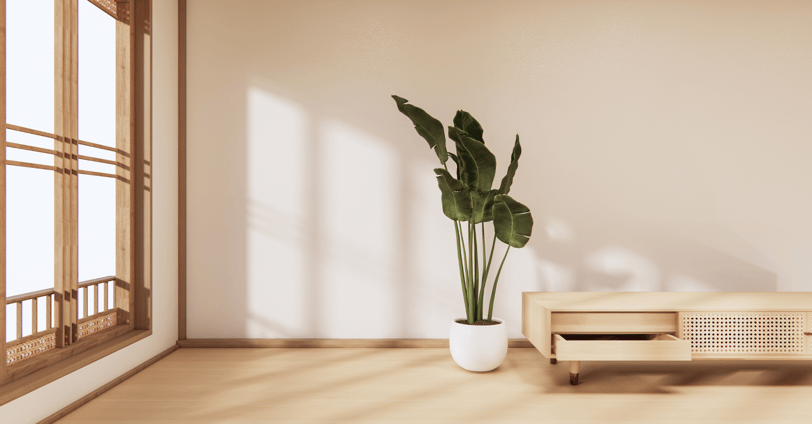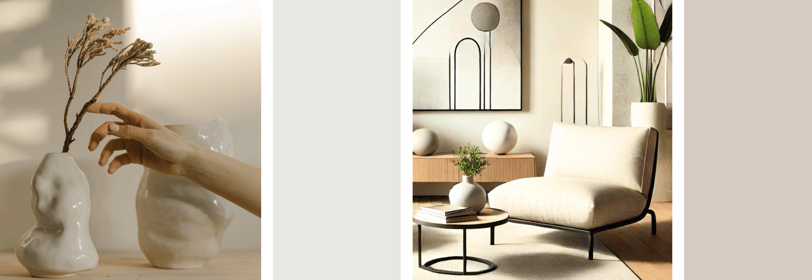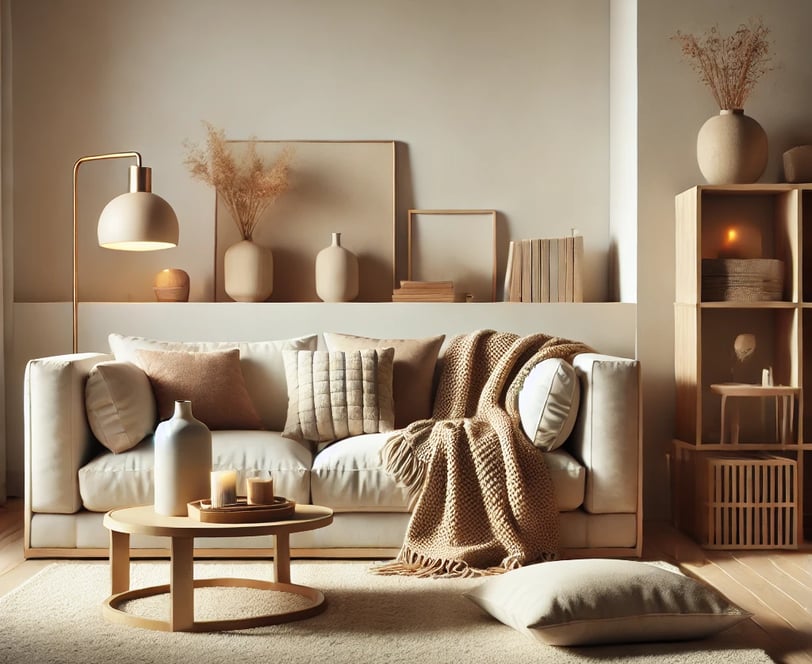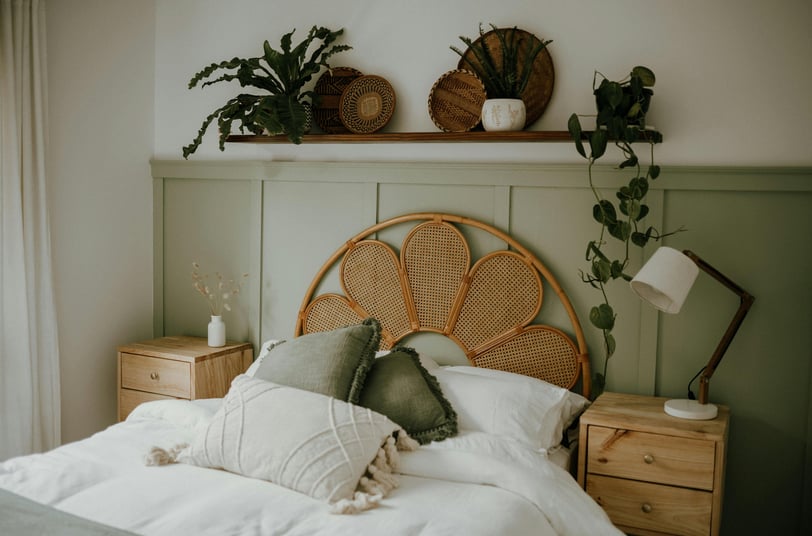10 Minimalist Aesthetic Trends to Transform Your Space in 2024-2025
Discover the top 10 minimalist aesthetic trends to transform your space in 2024-2025. From Nordic minimalism infused with hygge to the emerging Wabi-Sabi aesthetic, learn how to create a serene, modern home that reflects simplicity, style, and function.
AESTHETICS


Minimalism is more than just a design trend—it’s a lifestyle that emphasizes simplicity, intentionality, and calm. As we approach 2024-2025, minimalist home decor continues to evolve, focusing on timeless elegance, sustainable practices, and functional design. Whether you’re looking to revamp your entire home or update a single room, these ten minimalist trends will help you create a space that is both aesthetically pleasing and practical. Minimalism promotes clarity and peace of mind by creating environments that allow the essential to stand out while cutting out distractions. Below are ten transformative minimalist trends, along with unique insights, real-life applications, and expert perspectives, to reshape how you live and interact with your space in the upcoming years.
1. Neutral Color Palettes with Depth
While minimalism is often associated with neutral tones, the color trends of 2024-2025 introduce deeper hues to enhance the depth and warmth of your home. Classic shades like whites, beiges, and soft grays remain foundational, but there’s a noticeable shift towards incorporating richer tones like muted olives, terracotta, and deep blues. These colors add a sense of warmth without overwhelming the senses, creating a cozy yet airy atmosphere. These hues are believed to promote relaxation and focus, making them ideal for creating serene living spaces.
Try incorporating accent pieces like throw blankets or curtains in these richer tones to subtly introduce color into your minimalist space. Look for low-VOC paints to align with sustainable practices.
Trend Prediction Score: 4/5 - Highly popular and versatile for both residential and commercial spaces.


2. Natural Materials and Textures
Natural materials are a cornerstone of minimalist design, but in 2024-2025, there’s an emphasis on highlighting raw, unrefined beauty. This year’s trend showcases imperfections in nature—think visible wood grains, organic veining in stone, and the texture of handwoven fabrics. This aesthetic not only celebrates nature but also fosters a grounded, tranquil environment that encourages mindfulness. The emphasis on natural, raw materials is closely tied to the 'slow aesthetics' movement, which focuses on mindful consumption and sustainability. Read more about this growing trend in our guide to slow aesthetics in 2025.
Incorporate natural materials through small elements like wooden bowls, stone planters, or linen throws to create a cohesive, nature-inspired aesthetic.
Trend Prediction Score: 5/5 - Expected to dominate 2024-2025.
3. Multi-Functional and Space-Saving Furniture
Minimalism in 2024-2025 emphasizes multi-functional furniture that allows you to optimize space without clutter. Think of beds with built-in storage, desks that can double as vanity tables, or expandable dining tables. This trend particularly benefits urban dwellers where space is at a premium, offering functional yet visually clean solutions. To see more space-saving ideas, especially for those who work from home, check out our article on aesthetic home office ideas for 2024-2025.
Opt for modular sofas or wall-mounted desks to free up floor space and maintain a minimalist vibe.
Trend Prediction Score: 4/5
4. Nordic Minimalism: Infusing Hygge and Warmth
While traditional minimalism can sometimes feel stark, Nordic Minimalism introduces a sense of warmth and coziness through hygge—a Danish concept centered around comfort, well-being, and enjoying the simple pleasures in life. This style emphasizes softer textures, warm neutrals, and elements that evoke a feeling of contentment. Think plush throws, natural wood finishes, and cozy nooks designed for relaxation. Every piece in Nordic Minimalism serves both a functional and aesthetic purpose, reinforcing the principle of “living with intention”.
Introduce hygge elements by adding plush pillows and blankets in neutral tones, or create a dedicated reading nook using soft lighting and layered textiles.
Trend Prediction Score: 4/5


5. Wabi-Sabi Minimalism: Celebrating Imperfection and Transience
Unlike the structured forms and clean lines of traditional minimalism, Wabi-Sabi Minimalism embraces imperfections, asymmetry, and the beauty of natural aging. Rooted in Japanese philosophy, Wabi-Sabi focuses on the acceptance of imperfection and impermanence, making it an ideal counterbalance to perfectionist minimalist aesthetics. This style incorporates raw materials, organic shapes, and subtle imperfections, giving organic feel. Interiors inspired by this style often feature a muted color palette, handmade ceramics, and furniture with weathered finishes that tell a story. Wabi-Sabi’s emphasis on sustainability aligns with the growing demand for eco-conscious living. Discover more about how embracing sustainability can transform not only your home but the environment in our post on breaking the plastic habit.
Choose handmade decor pieces, or add a statement piece like a vintage table with visible wear and tear that adds character to your space.
Trend Prediction Score: 5/5 - Gaining attention for its authenticity and focus on sustainability
6. Mindful Lighting Design
Lighting is a critical element in minimalist spaces, and for 2024-2025, the trend is toward mindful lighting designs that balance natural and artificial light. Using ambient, task, and accent lighting allows you to create different moods within the same space, enhancing its versatility. Warm, diffused lighting softens sharp edges and makes rooms feel more inviting.
Invest in dimmable LED lights or smart bulbs that allow you to adjust the ambiance based on your needs—bright and energizing in the morning, warm and calming in the evening.
Trend Prediction Score: 5/5
7. Sustainable and Eco-Friendly Decor
Sustainability is becoming an integral part of home decor trends, and in 2024-2025, eco-friendly minimalist spaces are setting the new gold standard. Materials like reclaimed wood, bamboo, and recycled metals are favored for their eco-conscious properties. This trend supports both environmental sustainability and minimalist principles of "mindful consumption." Incorporating sustainable decor doesn't have to break the bank though. Explore our top affordable eco-friendly products to start making greener choices today.
Start small by switching to eco-friendly materials for your decor, like bamboo utensils or recycled glass vases, and gradually replace larger furniture items with sustainably sourced pieces.
Trend Prediction Score: 5/5 - Major growth area
8. Biophilic Design Elements
Biophilic design, which integrates natural elements into home environments, continues to rise in popularity for minimalist spaces. Indoor plants, living walls, and natural water features create a calming, nature-inspired environment while complementing minimalist interiors. These elements enhance tranquility and improve indoor air quality. Integrating biophilic design encourages connection to nature, much like adopting a zero-waste lifestyle. Learn more about starting your eco-friendly journey with our zero-waste living guide.
Place a few small plants in key areas like your living room or workspace. Start with low-maintenance plants if you’re new to indoor gardening.
Trend Prediction Score: 5/5


9. Hidden Storage Solutions
Decluttering is a key aspect of maintaining a minimalist space, but for 2024-2025, the focus shifts to using hidden storage solutions to keep things out of sight. Built-in cabinets, under-bed storage, and hidden shelving are becoming the go-to choices for maintaining a clean, streamlined look. This trend is perfect for those looking to balance minimalism with practical living.
Explore modular storage options that can be customized to fit your needs. Consider using hidden compartments in furniture pieces like ottomans or beds to maximize space without sacrificing style.
Trend Prediction Score: 4/5
10. Minimalist Smart Home Technology
Smart home technology is evolving to complement minimalist design. In 2024-2025, expect to see seamless integration of smart devices that blend into the decor—think sleek smart thermostats, voice-controlled lighting, and under-the-radar home assistants. This trend focuses on creating spaces that are not only visually clean but also functionally enhanced through technology.
Start with a few foundational smart devices, like a minimalist-designed smart speaker or thermostat, and gradually build up your system to avoid tech clutter.
Trend Prediction Score: 5/5 - Expected to grow exponentially.


Beyond Aesthetics
The minimalist trends for 2024-2025 are not just about creating beautiful spaces—they’re about fostering environments that support well-being, sustainability, and intentional living. Whether you’re starting small or planning a complete home makeover, remember that the essence of minimalism lies in creating spaces that enhance your quality of life. Focus on the elements that resonate with you and don’t be afraid to adapt these trends to suit your personal needs.
Key takeaways:
Holistic Approach: Minimalist trends prioritize well-being and sustainability, encouraging spaces that nurture both mind and environment.
Integration of Styles: Trends like Nordic Minimalism and Wabi-Sabi promote blending different elements for personalized spaces that resonate with individual lifestyles.
Focus on Functionality: Successful minimalist design balances beauty and practicality with multi-functional furniture and hidden storage solutions.
Stay inspired by following my social media accounts for more valuable tips on minimalist living!
Q&As
What is the minimalist aesthetic, and why is it popular?
The minimalist aesthetic emphasizes simplicity, functionality, and calm. It's popular because it promotes a clutter-free, organized space that enhances mental clarity and reduces stress. As we move into 2024-2025, minimalism continues to evolve, integrating sustainability and wellness into its core principles.
How do I start creating a minimalist space?
Start by decluttering and removing items that don’t serve a purpose or bring joy. Focus on a neutral color palette, clean lines, and multi-functional furniture. Gradually introduce natural materials and biophilic elements to create a balanced and serene environment.
How do I incorporate biophilic design into a minimalist space?
Start small by adding low-maintenance plants or using natural textures like wood and stone. Consider elements like indoor gardens or water features to further enhance the biophilic experience.
What are the main differences between traditional minimalism and Nordic minimalism?
Traditional minimalism emphasizes functionality and simplicity, often using stark, clean lines, neutral color palettes, and a focus on reducing excess. It seeks to eliminate distractions and create an uncluttered space. In contrast, Nordic minimalism incorporates elements of warmth and coziness through the Danish concept of hygge.
What is the philosophy behind Wabi-Sabi in interior design?
The philosophy of Wabi-Sabi in interior design stems from embracing imperfection and the beauty of aging and natural decay. It values the patina that comes with time, such as a weathered wooden table or a faded fabric. Instead of striving for perfection, Wabi-Sabi design encourages a sense of calm and authenticity, reminding us that everything is transient.
Can Wabi-Sabi and modern minimalism be combined?
Yes, Wabi-Sabi and modern minimalism can be beautifully combined. Both styles prioritize simplicity and intentional living, but while minimalism often focuses on clean lines and removing excess, Wabi-Sabi introduces an element of imperfection and natural beauty. By blending these approaches, you can create a space that is both uncluttered and emotionally resonant.










